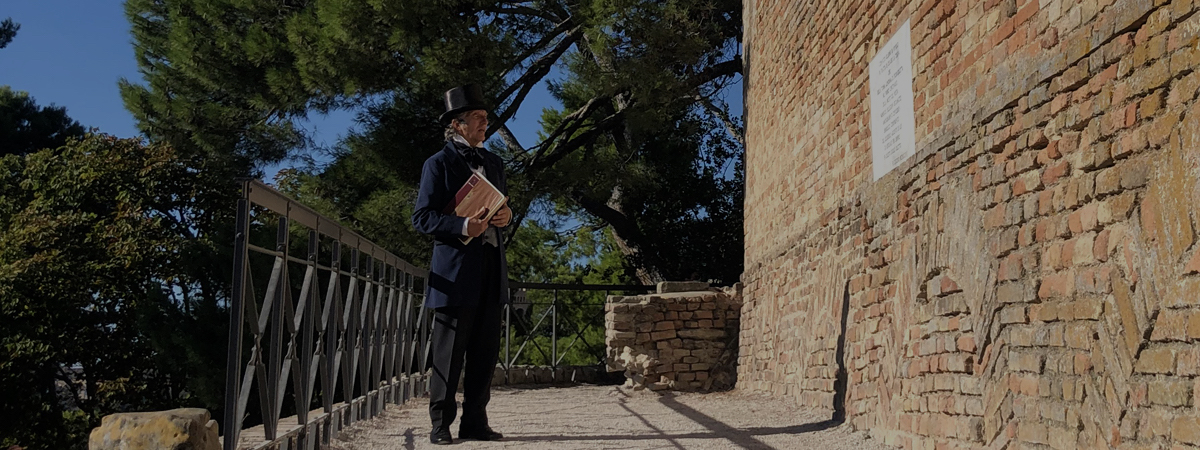Lorenzo Lotto in Recanati
RECANATI
RECANATI, ADRIATIC CITY AND HARBOR
The castrum of Recanati has existed since 1139, while the municipality since 1174.
Since 1202 the municipality has expanded to the coast where the dominion is confirmed by Emperor Frederick II in 1229. A treaty signed with Ragusa (Dubrovnik) proves the existence of a port or at least of a landing place on the Adriatic Sea already in the year 1206.
In 1240, Recanati was elevated to the rank of city and in 1357 it was among the urban centers of the pontifical brand placed among the civitatis magnae. Commercial traffic, the presence of a warehouse to store goods, the presence of the port captain, the establishment of a customs office are all elements that attest to the importance of the port of Recanati between the 14th and 16th centuries. All this, as Marco Moroni states, only strengthens the city’s bond with the sea: Recanati is truly an Adriatic city.
RECANATI AND THE FAIR
Between the 15th and 16th centuries, the population of Recanati fluctuated between 6000 and 7000 inhabitants. Rome had approximately 55,000, Ancona 18,000, Venice 200,000. The city was part of the Marca d’Ancona governed by a papal legate (and deputy legate) who resided in Macerata. When Lorenzo Lotto signed the contract for the polyptych of S. Domenico in Recanati in 1506, the papal legate was Alessandro Farnese the Elder (1502-1508), future Pope Paul III Sigismondo Gonzaga, son of Federico I, subsequently held this position from 24 February 1508 to 1514 and was Lorenzo Lotto’s client. In 1506, Recanati was a rich city and famous for its fair that took place from 1 September to 31 October each year and attracted thousands of merchants and buyers interested in fabrics, jewellery, books, but also works of art. The hub of the fair was the port of Recanati that had been further strengthened in the 15th century, using the mouth of the Potenza river, as a canal port with obvious repercussions on the fair, whose growth required an efficient transport service also between the port and the city, entrusted to transport companies “carriers”.
In 1511, the papal legate Sigismondo Gonzaga visited the fair, staying for a long time in Recanati with an entourage of one hundred horses and one hundred and sixty people: a positive presence for Lorenzo Lotto who executed two works for the important prelate, paid for in 1512. At the Recanati fair Lotto met the Cassottis and the Marchettis, merchants from Bergamo who were his future clients, documentary makers in Recanati from 1510 to 1514 and in the following years. They probably pushed him to go to work in Bergamo in 1513.
RECANATI AND LORETO
Both the port of Ancona and the smaller one of Recanati were also landing points for pilgrims heading to the Sanctuary of the Holy House of Loreto. A few kilometers from Recanati, the marian shrine was one of the most important places of pilgrimage in Christianity and until 1507 it was also under the administrative jurisdiction of Recanati. In that year Julius II took away from the bishop of Recanati all jurisdiction over the sanctuary, over its ministers but also over the pilgrims and inhabitants of Loreto until in 1586 Sixtus V, elevating Loreto to the rank of city, definitively removed jurisdiction over the community from the municipality of Recanati.
LORENZO LOTTO AND HIS ARRIVAL IN RECANATI
While traveling in the Adriatic Sea, then called the Gulf of Venice, pilot books were used for orientation in the sea. We traveled by tacking, always keeping the coast in mind.
The Adriatic was the sea of Venice, Ancona and Ragusa, a narrow and long gulf that connected the coastal cities also with small coasting ships that could also navigate internal waterways such as rivers and canals. Coming down from Venice by sea, Lorenzo Lotto arrived on the coast of what is now Marche after passing the port of Pesaro and the landing place of Case Bruciate (now the municipality of Montemarciano), which was a gabelle at the mouth of the Esino river.
It is not excluded, that he could have landed in the port of Ancona, recognizable from afar by the cathedral of San Ciriaco that stands out on the ancient acropolis of the city, and from here, with a lighter boat, arrived in the port of Recanati near the Swabian Castle at the mouth of the Potenza River. From there he continued to Recanati traveling on the back of a mule, or perhaps on a cart pulled by a pair of oxen, leaving the woods close to the coastal strip between the Musone and Potenza rivers. He travelled through a rich landscape, admired and praised in 1523 by Venetian ambassadors traveling to Rome, where the walled cities were surrounded by vegetable gardens and gardens with fruit trees, hazelnuts, almond trees, walnuts and even citrus fruits.
All around he could see the fields, cultivated with wheat, olive trees and vineyards and dotted with oak trees and diving towers.
In the distance, he could contemplate the shrine of Loreto, with the large dome by Giuliano da Sangallo as majestic as that of Brunelleschi in Florence, with the bastioned apses for defensive purposes designed by Baccio Pontelli and the mighty city walls, completed in 1520. Lorenzo Lotto frequented and knew Loreto: at the time, work was in full swing on the basilica, the marble cladding of the Holy House designed by Bramante, and the construction of the grandiose apostolic palace. Loreto was an artistic construction site and a cornerstone sanctuary of the Catholic Church.
But why was the Venetian master called to Recanati and who called him? The question still lacks a comprehensive answer. There are those who think of the relationship with the Dominicans, those who think of the possibility that the artist attended the fair before 1506.
The landscape: what did Lotto see? Cathedral of S. Ciriaco from above; port of Ancona; Conero (Berlin opera background); countryside (background work Carrara di Bergamo); countryside towards Loreto; pilot book.
LORENZO LOTTO: WORKS FOR RECANATI
After the success achieved in Treviso between the beginning of the century and 1506, so much so that in 1505 Lorenzo Lotto was defined as “pictor celeberrimus“, on 17 June he was in Recanati to sign the contract for the polyptych of San Domenico, delivered in 1508 , which he will paint in a room of the Dominican convent. He was very active in the city and his fame spread throughout the area: in 1511 he was working on the Transfiguration of Christ for the church of S. Maria di Castelnuovo di Recanati
He goes to Jesi to sign the contract for the Deposition that he will deliver in 1512
In 1512, he gets the money from the treasury of Sigismondo Gonzaga, Legate of the Marche since 1509 and resident between Mantua and Macerata, for the execution of two paintings, one of which could be Judith with the head of Holofernes.
The small painting with San Giacomo Pellegrino and the fresco depicting San Vincenzo Ferrer in glory for the Church of San Domenico also date back to these years.
Other masterpieces by the artist preserved in Italian and foreign museums date back to these years of activity in the Marche:
- The Madonna and Child with Saints of Krakow
- The Dresden bust of Christ
- The Madonna and Child between San Flaviano and Sant’Onofrio in the Borghese gallery in Rome
- Judith with the head of Holofernes in a private collection*
- The Portrait of a prelate perhaps depicting Sigismondo Gonzaga of Madrid
- Saint Jerome in a landscape of Bucharest
From local sources, we know that other works by Lotto were present on the church altars in Recanati and in the collection of Giovanni Francesco Angelita, historian of the city.



